Analyzing Strengths-Based Nursing Principles in Emma Gee's Case Study
VerifiedAdded on 2020/04/29
|12
|3660
|621
Report
AI Summary
This report provides an in-depth analysis of strengths-based nursing principles, focusing on the case of Emma Gee. It explores how these principles can be applied throughout a patient's healthcare journey to promote healing and health. The report discusses the core values of strengths-based nursing, emphasizing the importance of focusing on a patient's inner and outer strengths, and the role of nurses in facilitating this approach. It examines critical transformation points in Emma Gee's journey, particularly the post-surgical care of an unconscious patient, and presents a strengths-based nursing care plan that incorporates family involvement and collaboration with other healthcare professionals. The report also highlights the differences between the actual healthcare experiences and the ideal care that should be provided, emphasizing the importance of a holistic approach. The paper emphasizes on the need to focus on the strengths of an individual rather than deficits. The report also underlines the significance of empowering patients and fostering collaborative relationships among patients, clinicians, and other stakeholders. The study also discusses the importance of the ABCD approach to resuscitation and the need to continuously monitor the patient's condition. Overall, the report highlights the benefits of strengths-based nursing in improving patient outcomes and promoting patient empowerment.
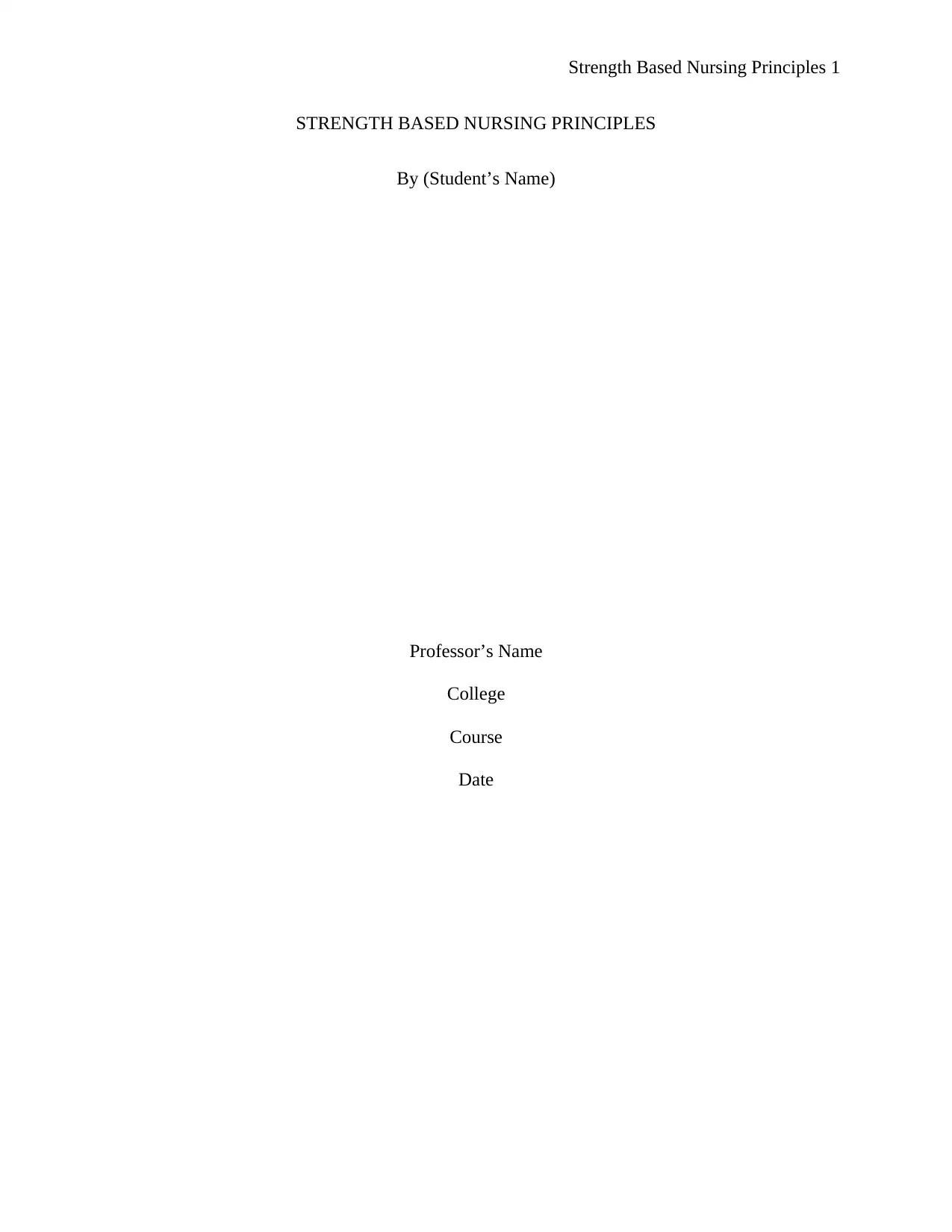
Strength Based Nursing Principles 1
STRENGTH BASED NURSING PRINCIPLES
By (Student’s Name)
Professor’s Name
College
Course
Date
STRENGTH BASED NURSING PRINCIPLES
By (Student’s Name)
Professor’s Name
College
Course
Date
Paraphrase This Document
Need a fresh take? Get an instant paraphrase of this document with our AI Paraphraser
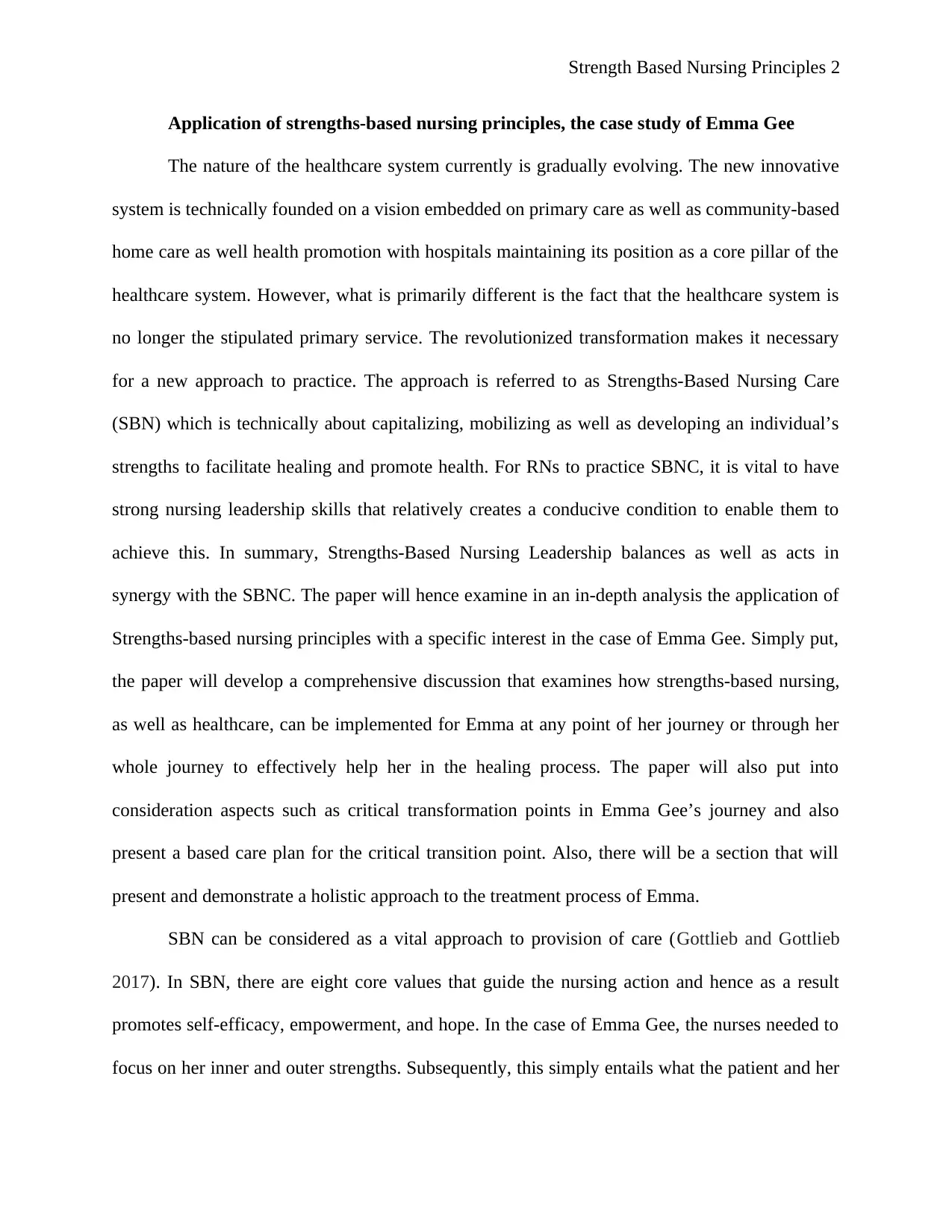
Strength Based Nursing Principles 2
Application of strengths-based nursing principles, the case study of Emma Gee
The nature of the healthcare system currently is gradually evolving. The new innovative
system is technically founded on a vision embedded on primary care as well as community-based
home care as well health promotion with hospitals maintaining its position as a core pillar of the
healthcare system. However, what is primarily different is the fact that the healthcare system is
no longer the stipulated primary service. The revolutionized transformation makes it necessary
for a new approach to practice. The approach is referred to as Strengths-Based Nursing Care
(SBN) which is technically about capitalizing, mobilizing as well as developing an individual’s
strengths to facilitate healing and promote health. For RNs to practice SBNC, it is vital to have
strong nursing leadership skills that relatively creates a conducive condition to enable them to
achieve this. In summary, Strengths-Based Nursing Leadership balances as well as acts in
synergy with the SBNC. The paper will hence examine in an in-depth analysis the application of
Strengths-based nursing principles with a specific interest in the case of Emma Gee. Simply put,
the paper will develop a comprehensive discussion that examines how strengths-based nursing,
as well as healthcare, can be implemented for Emma at any point of her journey or through her
whole journey to effectively help her in the healing process. The paper will also put into
consideration aspects such as critical transformation points in Emma Gee’s journey and also
present a based care plan for the critical transition point. Also, there will be a section that will
present and demonstrate a holistic approach to the treatment process of Emma.
SBN can be considered as a vital approach to provision of care (Gottlieb and Gottlieb
2017). In SBN, there are eight core values that guide the nursing action and hence as a result
promotes self-efficacy, empowerment, and hope. In the case of Emma Gee, the nurses needed to
focus on her inner and outer strengths. Subsequently, this simply entails what the patient and her
Application of strengths-based nursing principles, the case study of Emma Gee
The nature of the healthcare system currently is gradually evolving. The new innovative
system is technically founded on a vision embedded on primary care as well as community-based
home care as well health promotion with hospitals maintaining its position as a core pillar of the
healthcare system. However, what is primarily different is the fact that the healthcare system is
no longer the stipulated primary service. The revolutionized transformation makes it necessary
for a new approach to practice. The approach is referred to as Strengths-Based Nursing Care
(SBN) which is technically about capitalizing, mobilizing as well as developing an individual’s
strengths to facilitate healing and promote health. For RNs to practice SBNC, it is vital to have
strong nursing leadership skills that relatively creates a conducive condition to enable them to
achieve this. In summary, Strengths-Based Nursing Leadership balances as well as acts in
synergy with the SBNC. The paper will hence examine in an in-depth analysis the application of
Strengths-based nursing principles with a specific interest in the case of Emma Gee. Simply put,
the paper will develop a comprehensive discussion that examines how strengths-based nursing,
as well as healthcare, can be implemented for Emma at any point of her journey or through her
whole journey to effectively help her in the healing process. The paper will also put into
consideration aspects such as critical transformation points in Emma Gee’s journey and also
present a based care plan for the critical transition point. Also, there will be a section that will
present and demonstrate a holistic approach to the treatment process of Emma.
SBN can be considered as a vital approach to provision of care (Gottlieb and Gottlieb
2017). In SBN, there are eight core values that guide the nursing action and hence as a result
promotes self-efficacy, empowerment, and hope. In the case of Emma Gee, the nurses needed to
focus on her inner and outer strengths. Subsequently, this simply entails what the patient and her
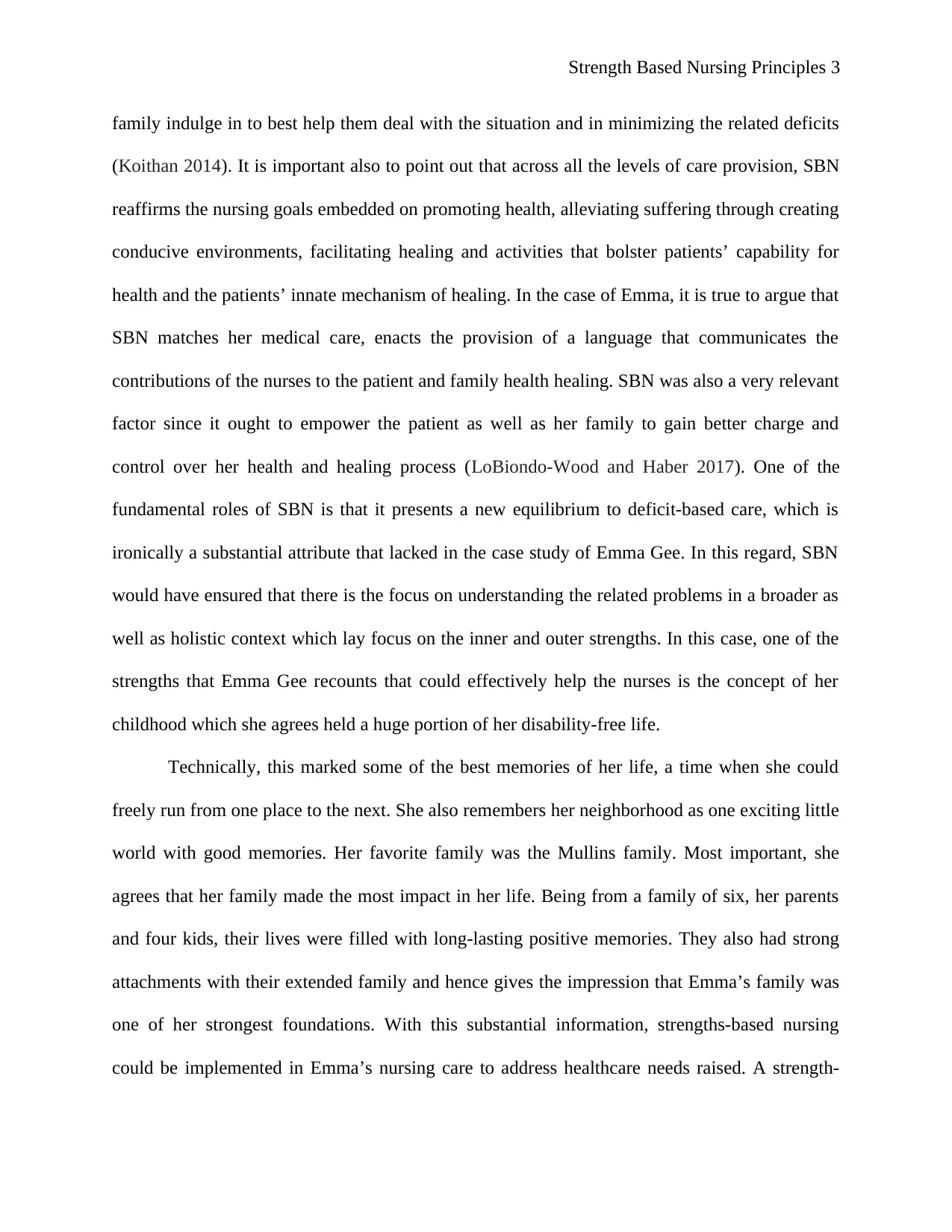
Strength Based Nursing Principles 3
family indulge in to best help them deal with the situation and in minimizing the related deficits
(Koithan 2014). It is important also to point out that across all the levels of care provision, SBN
reaffirms the nursing goals embedded on promoting health, alleviating suffering through creating
conducive environments, facilitating healing and activities that bolster patients’ capability for
health and the patients’ innate mechanism of healing. In the case of Emma, it is true to argue that
SBN matches her medical care, enacts the provision of a language that communicates the
contributions of the nurses to the patient and family health healing. SBN was also a very relevant
factor since it ought to empower the patient as well as her family to gain better charge and
control over her health and healing process (LoBiondo-Wood and Haber 2017). One of the
fundamental roles of SBN is that it presents a new equilibrium to deficit-based care, which is
ironically a substantial attribute that lacked in the case study of Emma Gee. In this regard, SBN
would have ensured that there is the focus on understanding the related problems in a broader as
well as holistic context which lay focus on the inner and outer strengths. In this case, one of the
strengths that Emma Gee recounts that could effectively help the nurses is the concept of her
childhood which she agrees held a huge portion of her disability-free life.
Technically, this marked some of the best memories of her life, a time when she could
freely run from one place to the next. She also remembers her neighborhood as one exciting little
world with good memories. Her favorite family was the Mullins family. Most important, she
agrees that her family made the most impact in her life. Being from a family of six, her parents
and four kids, their lives were filled with long-lasting positive memories. They also had strong
attachments with their extended family and hence gives the impression that Emma’s family was
one of her strongest foundations. With this substantial information, strengths-based nursing
could be implemented in Emma’s nursing care to address healthcare needs raised. A strength-
family indulge in to best help them deal with the situation and in minimizing the related deficits
(Koithan 2014). It is important also to point out that across all the levels of care provision, SBN
reaffirms the nursing goals embedded on promoting health, alleviating suffering through creating
conducive environments, facilitating healing and activities that bolster patients’ capability for
health and the patients’ innate mechanism of healing. In the case of Emma, it is true to argue that
SBN matches her medical care, enacts the provision of a language that communicates the
contributions of the nurses to the patient and family health healing. SBN was also a very relevant
factor since it ought to empower the patient as well as her family to gain better charge and
control over her health and healing process (LoBiondo-Wood and Haber 2017). One of the
fundamental roles of SBN is that it presents a new equilibrium to deficit-based care, which is
ironically a substantial attribute that lacked in the case study of Emma Gee. In this regard, SBN
would have ensured that there is the focus on understanding the related problems in a broader as
well as holistic context which lay focus on the inner and outer strengths. In this case, one of the
strengths that Emma Gee recounts that could effectively help the nurses is the concept of her
childhood which she agrees held a huge portion of her disability-free life.
Technically, this marked some of the best memories of her life, a time when she could
freely run from one place to the next. She also remembers her neighborhood as one exciting little
world with good memories. Her favorite family was the Mullins family. Most important, she
agrees that her family made the most impact in her life. Being from a family of six, her parents
and four kids, their lives were filled with long-lasting positive memories. They also had strong
attachments with their extended family and hence gives the impression that Emma’s family was
one of her strongest foundations. With this substantial information, strengths-based nursing
could be implemented in Emma’s nursing care to address healthcare needs raised. A strength-
⊘ This is a preview!⊘
Do you want full access?
Subscribe today to unlock all pages.

Trusted by 1+ million students worldwide
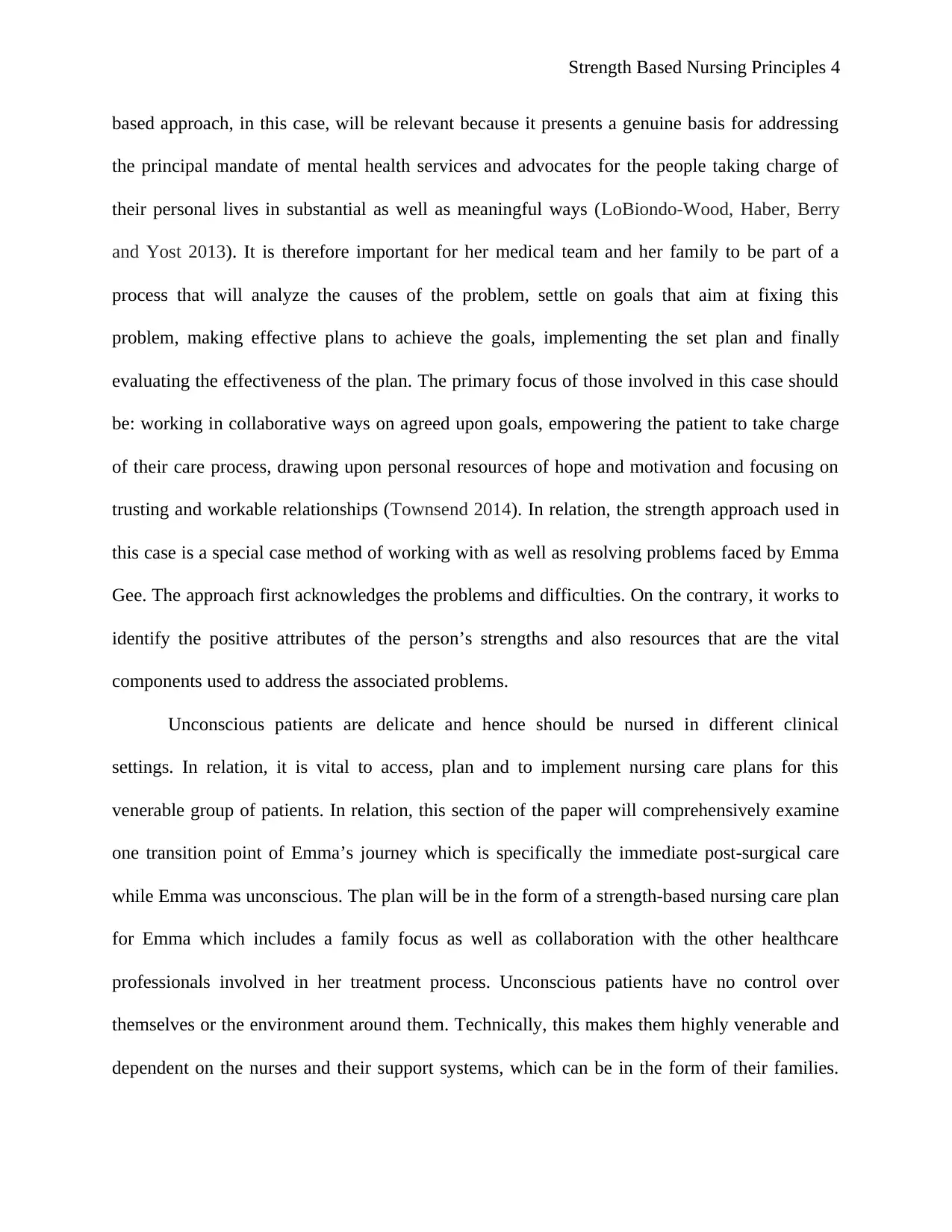
Strength Based Nursing Principles 4
based approach, in this case, will be relevant because it presents a genuine basis for addressing
the principal mandate of mental health services and advocates for the people taking charge of
their personal lives in substantial as well as meaningful ways (LoBiondo-Wood, Haber, Berry
and Yost 2013). It is therefore important for her medical team and her family to be part of a
process that will analyze the causes of the problem, settle on goals that aim at fixing this
problem, making effective plans to achieve the goals, implementing the set plan and finally
evaluating the effectiveness of the plan. The primary focus of those involved in this case should
be: working in collaborative ways on agreed upon goals, empowering the patient to take charge
of their care process, drawing upon personal resources of hope and motivation and focusing on
trusting and workable relationships (Townsend 2014). In relation, the strength approach used in
this case is a special case method of working with as well as resolving problems faced by Emma
Gee. The approach first acknowledges the problems and difficulties. On the contrary, it works to
identify the positive attributes of the person’s strengths and also resources that are the vital
components used to address the associated problems.
Unconscious patients are delicate and hence should be nursed in different clinical
settings. In relation, it is vital to access, plan and to implement nursing care plans for this
venerable group of patients. In relation, this section of the paper will comprehensively examine
one transition point of Emma’s journey which is specifically the immediate post-surgical care
while Emma was unconscious. The plan will be in the form of a strength-based nursing care plan
for Emma which includes a family focus as well as collaboration with the other healthcare
professionals involved in her treatment process. Unconscious patients have no control over
themselves or the environment around them. Technically, this makes them highly venerable and
dependent on the nurses and their support systems, which can be in the form of their families.
based approach, in this case, will be relevant because it presents a genuine basis for addressing
the principal mandate of mental health services and advocates for the people taking charge of
their personal lives in substantial as well as meaningful ways (LoBiondo-Wood, Haber, Berry
and Yost 2013). It is therefore important for her medical team and her family to be part of a
process that will analyze the causes of the problem, settle on goals that aim at fixing this
problem, making effective plans to achieve the goals, implementing the set plan and finally
evaluating the effectiveness of the plan. The primary focus of those involved in this case should
be: working in collaborative ways on agreed upon goals, empowering the patient to take charge
of their care process, drawing upon personal resources of hope and motivation and focusing on
trusting and workable relationships (Townsend 2014). In relation, the strength approach used in
this case is a special case method of working with as well as resolving problems faced by Emma
Gee. The approach first acknowledges the problems and difficulties. On the contrary, it works to
identify the positive attributes of the person’s strengths and also resources that are the vital
components used to address the associated problems.
Unconscious patients are delicate and hence should be nursed in different clinical
settings. In relation, it is vital to access, plan and to implement nursing care plans for this
venerable group of patients. In relation, this section of the paper will comprehensively examine
one transition point of Emma’s journey which is specifically the immediate post-surgical care
while Emma was unconscious. The plan will be in the form of a strength-based nursing care plan
for Emma which includes a family focus as well as collaboration with the other healthcare
professionals involved in her treatment process. Unconscious patients have no control over
themselves or the environment around them. Technically, this makes them highly venerable and
dependent on the nurses and their support systems, which can be in the form of their families.
Paraphrase This Document
Need a fresh take? Get an instant paraphrase of this document with our AI Paraphraser
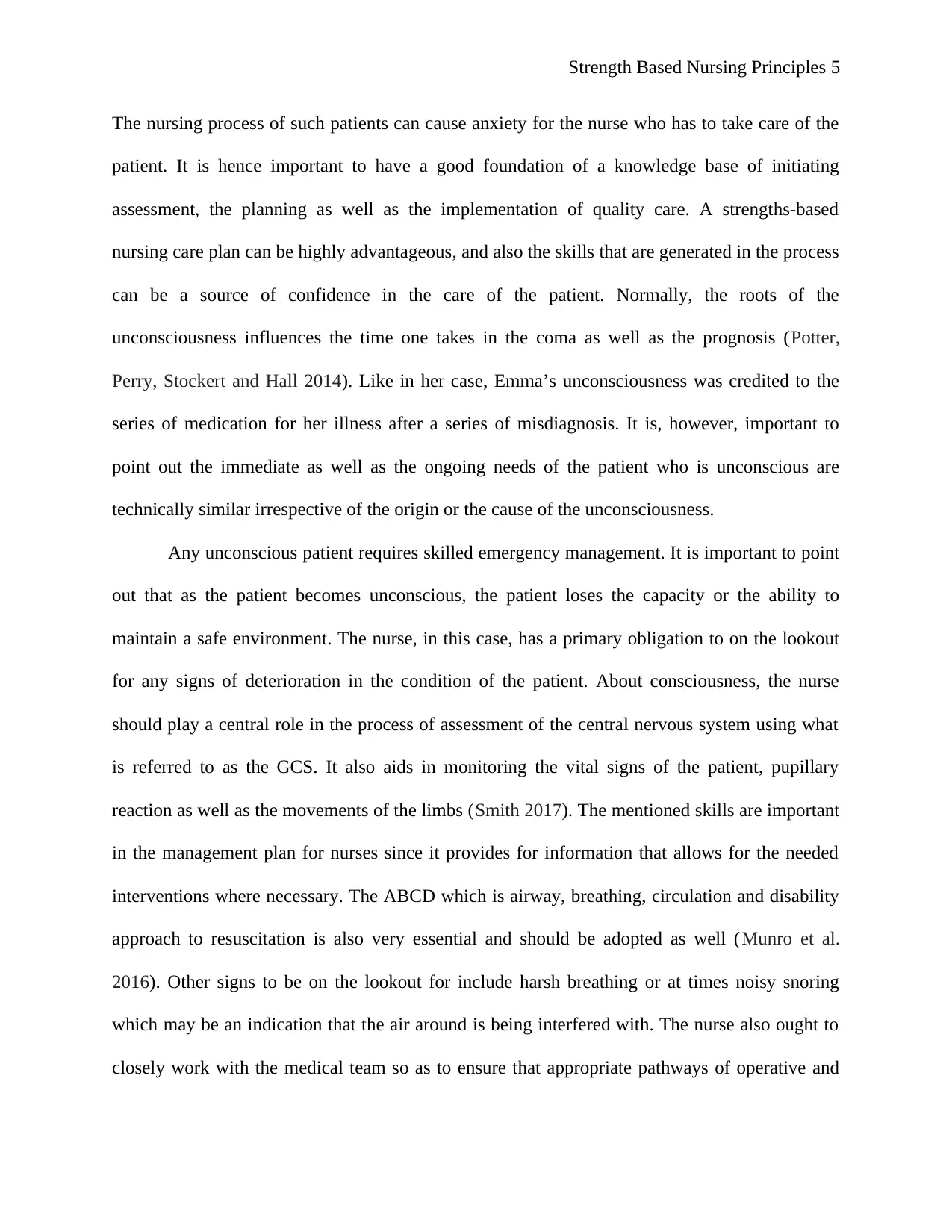
Strength Based Nursing Principles 5
The nursing process of such patients can cause anxiety for the nurse who has to take care of the
patient. It is hence important to have a good foundation of a knowledge base of initiating
assessment, the planning as well as the implementation of quality care. A strengths-based
nursing care plan can be highly advantageous, and also the skills that are generated in the process
can be a source of confidence in the care of the patient. Normally, the roots of the
unconsciousness influences the time one takes in the coma as well as the prognosis (Potter,
Perry, Stockert and Hall 2014). Like in her case, Emma’s unconsciousness was credited to the
series of medication for her illness after a series of misdiagnosis. It is, however, important to
point out the immediate as well as the ongoing needs of the patient who is unconscious are
technically similar irrespective of the origin or the cause of the unconsciousness.
Any unconscious patient requires skilled emergency management. It is important to point
out that as the patient becomes unconscious, the patient loses the capacity or the ability to
maintain a safe environment. The nurse, in this case, has a primary obligation to on the lookout
for any signs of deterioration in the condition of the patient. About consciousness, the nurse
should play a central role in the process of assessment of the central nervous system using what
is referred to as the GCS. It also aids in monitoring the vital signs of the patient, pupillary
reaction as well as the movements of the limbs (Smith 2017). The mentioned skills are important
in the management plan for nurses since it provides for information that allows for the needed
interventions where necessary. The ABCD which is airway, breathing, circulation and disability
approach to resuscitation is also very essential and should be adopted as well (Munro et al.
2016). Other signs to be on the lookout for include harsh breathing or at times noisy snoring
which may be an indication that the air around is being interfered with. The nurse also ought to
closely work with the medical team so as to ensure that appropriate pathways of operative and
The nursing process of such patients can cause anxiety for the nurse who has to take care of the
patient. It is hence important to have a good foundation of a knowledge base of initiating
assessment, the planning as well as the implementation of quality care. A strengths-based
nursing care plan can be highly advantageous, and also the skills that are generated in the process
can be a source of confidence in the care of the patient. Normally, the roots of the
unconsciousness influences the time one takes in the coma as well as the prognosis (Potter,
Perry, Stockert and Hall 2014). Like in her case, Emma’s unconsciousness was credited to the
series of medication for her illness after a series of misdiagnosis. It is, however, important to
point out the immediate as well as the ongoing needs of the patient who is unconscious are
technically similar irrespective of the origin or the cause of the unconsciousness.
Any unconscious patient requires skilled emergency management. It is important to point
out that as the patient becomes unconscious, the patient loses the capacity or the ability to
maintain a safe environment. The nurse, in this case, has a primary obligation to on the lookout
for any signs of deterioration in the condition of the patient. About consciousness, the nurse
should play a central role in the process of assessment of the central nervous system using what
is referred to as the GCS. It also aids in monitoring the vital signs of the patient, pupillary
reaction as well as the movements of the limbs (Smith 2017). The mentioned skills are important
in the management plan for nurses since it provides for information that allows for the needed
interventions where necessary. The ABCD which is airway, breathing, circulation and disability
approach to resuscitation is also very essential and should be adopted as well (Munro et al.
2016). Other signs to be on the lookout for include harsh breathing or at times noisy snoring
which may be an indication that the air around is being interfered with. The nurse also ought to
closely work with the medical team so as to ensure that appropriate pathways of operative and
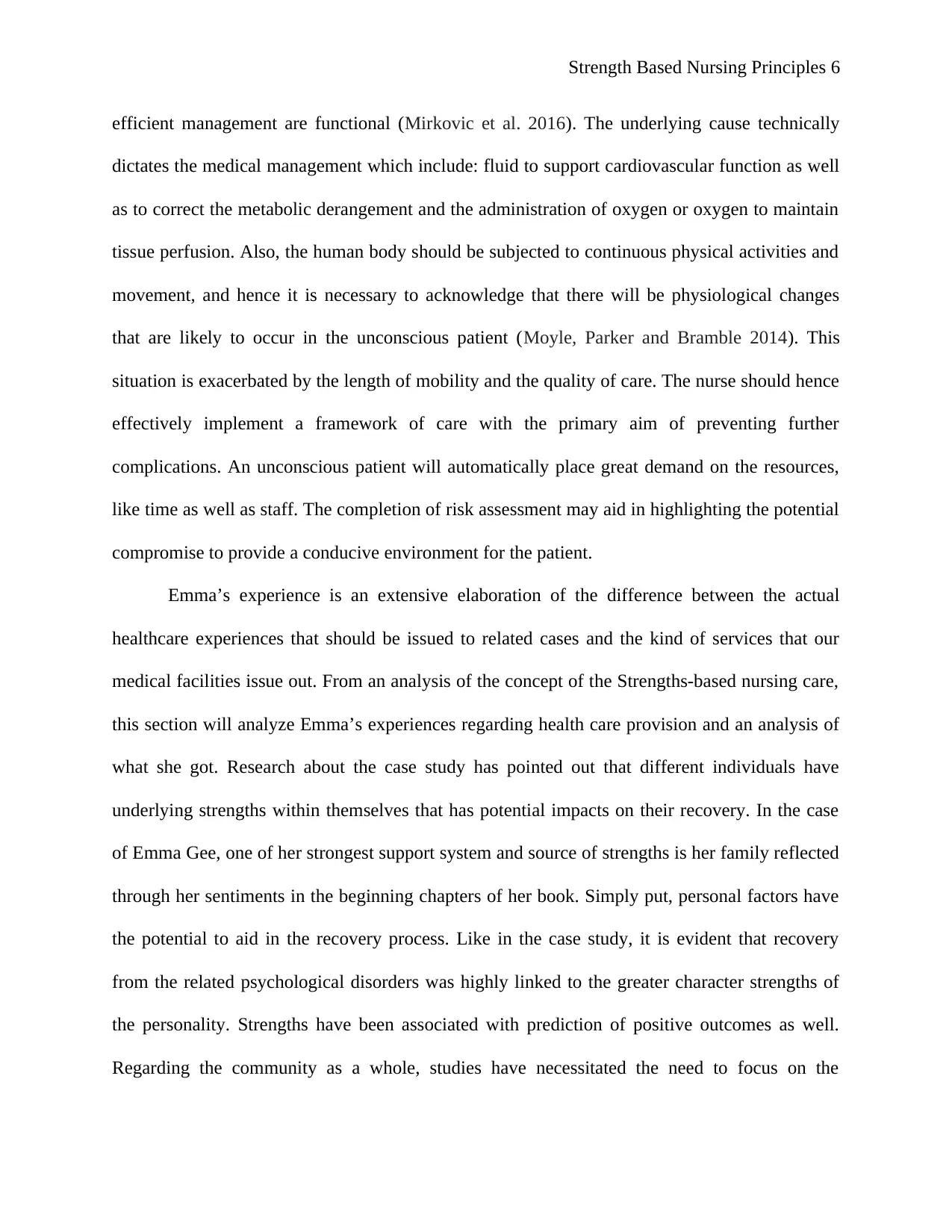
Strength Based Nursing Principles 6
efficient management are functional (Mirkovic et al. 2016). The underlying cause technically
dictates the medical management which include: fluid to support cardiovascular function as well
as to correct the metabolic derangement and the administration of oxygen or oxygen to maintain
tissue perfusion. Also, the human body should be subjected to continuous physical activities and
movement, and hence it is necessary to acknowledge that there will be physiological changes
that are likely to occur in the unconscious patient (Moyle, Parker and Bramble 2014). This
situation is exacerbated by the length of mobility and the quality of care. The nurse should hence
effectively implement a framework of care with the primary aim of preventing further
complications. An unconscious patient will automatically place great demand on the resources,
like time as well as staff. The completion of risk assessment may aid in highlighting the potential
compromise to provide a conducive environment for the patient.
Emma’s experience is an extensive elaboration of the difference between the actual
healthcare experiences that should be issued to related cases and the kind of services that our
medical facilities issue out. From an analysis of the concept of the Strengths-based nursing care,
this section will analyze Emma’s experiences regarding health care provision and an analysis of
what she got. Research about the case study has pointed out that different individuals have
underlying strengths within themselves that has potential impacts on their recovery. In the case
of Emma Gee, one of her strongest support system and source of strengths is her family reflected
through her sentiments in the beginning chapters of her book. Simply put, personal factors have
the potential to aid in the recovery process. Like in the case study, it is evident that recovery
from the related psychological disorders was highly linked to the greater character strengths of
the personality. Strengths have been associated with prediction of positive outcomes as well.
Regarding the community as a whole, studies have necessitated the need to focus on the
efficient management are functional (Mirkovic et al. 2016). The underlying cause technically
dictates the medical management which include: fluid to support cardiovascular function as well
as to correct the metabolic derangement and the administration of oxygen or oxygen to maintain
tissue perfusion. Also, the human body should be subjected to continuous physical activities and
movement, and hence it is necessary to acknowledge that there will be physiological changes
that are likely to occur in the unconscious patient (Moyle, Parker and Bramble 2014). This
situation is exacerbated by the length of mobility and the quality of care. The nurse should hence
effectively implement a framework of care with the primary aim of preventing further
complications. An unconscious patient will automatically place great demand on the resources,
like time as well as staff. The completion of risk assessment may aid in highlighting the potential
compromise to provide a conducive environment for the patient.
Emma’s experience is an extensive elaboration of the difference between the actual
healthcare experiences that should be issued to related cases and the kind of services that our
medical facilities issue out. From an analysis of the concept of the Strengths-based nursing care,
this section will analyze Emma’s experiences regarding health care provision and an analysis of
what she got. Research about the case study has pointed out that different individuals have
underlying strengths within themselves that has potential impacts on their recovery. In the case
of Emma Gee, one of her strongest support system and source of strengths is her family reflected
through her sentiments in the beginning chapters of her book. Simply put, personal factors have
the potential to aid in the recovery process. Like in the case study, it is evident that recovery
from the related psychological disorders was highly linked to the greater character strengths of
the personality. Strengths have been associated with prediction of positive outcomes as well.
Regarding the community as a whole, studies have necessitated the need to focus on the
⊘ This is a preview!⊘
Do you want full access?
Subscribe today to unlock all pages.

Trusted by 1+ million students worldwide
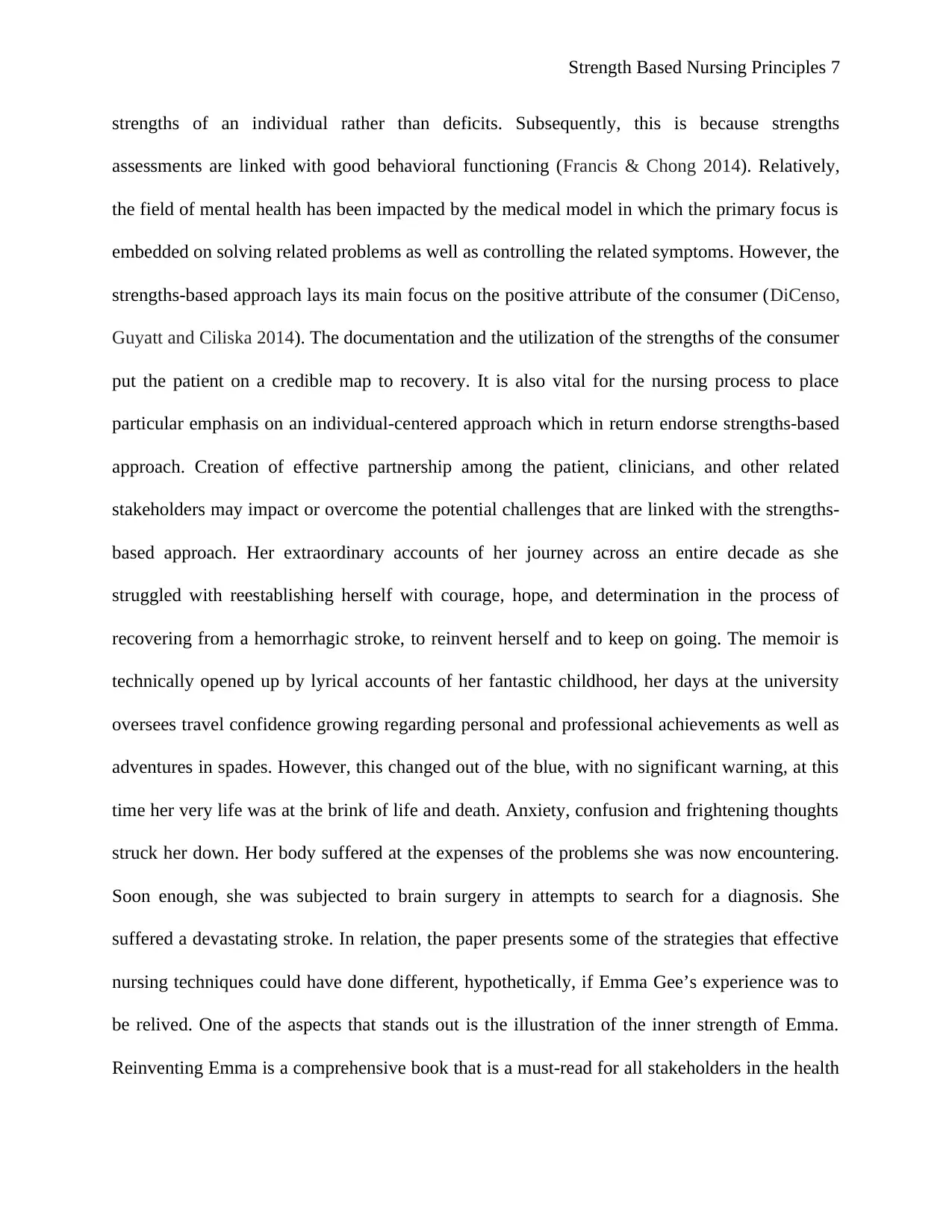
Strength Based Nursing Principles 7
strengths of an individual rather than deficits. Subsequently, this is because strengths
assessments are linked with good behavioral functioning (Francis & Chong 2014). Relatively,
the field of mental health has been impacted by the medical model in which the primary focus is
embedded on solving related problems as well as controlling the related symptoms. However, the
strengths-based approach lays its main focus on the positive attribute of the consumer (DiCenso,
Guyatt and Ciliska 2014). The documentation and the utilization of the strengths of the consumer
put the patient on a credible map to recovery. It is also vital for the nursing process to place
particular emphasis on an individual-centered approach which in return endorse strengths-based
approach. Creation of effective partnership among the patient, clinicians, and other related
stakeholders may impact or overcome the potential challenges that are linked with the strengths-
based approach. Her extraordinary accounts of her journey across an entire decade as she
struggled with reestablishing herself with courage, hope, and determination in the process of
recovering from a hemorrhagic stroke, to reinvent herself and to keep on going. The memoir is
technically opened up by lyrical accounts of her fantastic childhood, her days at the university
oversees travel confidence growing regarding personal and professional achievements as well as
adventures in spades. However, this changed out of the blue, with no significant warning, at this
time her very life was at the brink of life and death. Anxiety, confusion and frightening thoughts
struck her down. Her body suffered at the expenses of the problems she was now encountering.
Soon enough, she was subjected to brain surgery in attempts to search for a diagnosis. She
suffered a devastating stroke. In relation, the paper presents some of the strategies that effective
nursing techniques could have done different, hypothetically, if Emma Gee’s experience was to
be relived. One of the aspects that stands out is the illustration of the inner strength of Emma.
Reinventing Emma is a comprehensive book that is a must-read for all stakeholders in the health
strengths of an individual rather than deficits. Subsequently, this is because strengths
assessments are linked with good behavioral functioning (Francis & Chong 2014). Relatively,
the field of mental health has been impacted by the medical model in which the primary focus is
embedded on solving related problems as well as controlling the related symptoms. However, the
strengths-based approach lays its main focus on the positive attribute of the consumer (DiCenso,
Guyatt and Ciliska 2014). The documentation and the utilization of the strengths of the consumer
put the patient on a credible map to recovery. It is also vital for the nursing process to place
particular emphasis on an individual-centered approach which in return endorse strengths-based
approach. Creation of effective partnership among the patient, clinicians, and other related
stakeholders may impact or overcome the potential challenges that are linked with the strengths-
based approach. Her extraordinary accounts of her journey across an entire decade as she
struggled with reestablishing herself with courage, hope, and determination in the process of
recovering from a hemorrhagic stroke, to reinvent herself and to keep on going. The memoir is
technically opened up by lyrical accounts of her fantastic childhood, her days at the university
oversees travel confidence growing regarding personal and professional achievements as well as
adventures in spades. However, this changed out of the blue, with no significant warning, at this
time her very life was at the brink of life and death. Anxiety, confusion and frightening thoughts
struck her down. Her body suffered at the expenses of the problems she was now encountering.
Soon enough, she was subjected to brain surgery in attempts to search for a diagnosis. She
suffered a devastating stroke. In relation, the paper presents some of the strategies that effective
nursing techniques could have done different, hypothetically, if Emma Gee’s experience was to
be relived. One of the aspects that stands out is the illustration of the inner strength of Emma.
Reinventing Emma is a comprehensive book that is a must-read for all stakeholders in the health
Paraphrase This Document
Need a fresh take? Get an instant paraphrase of this document with our AI Paraphraser
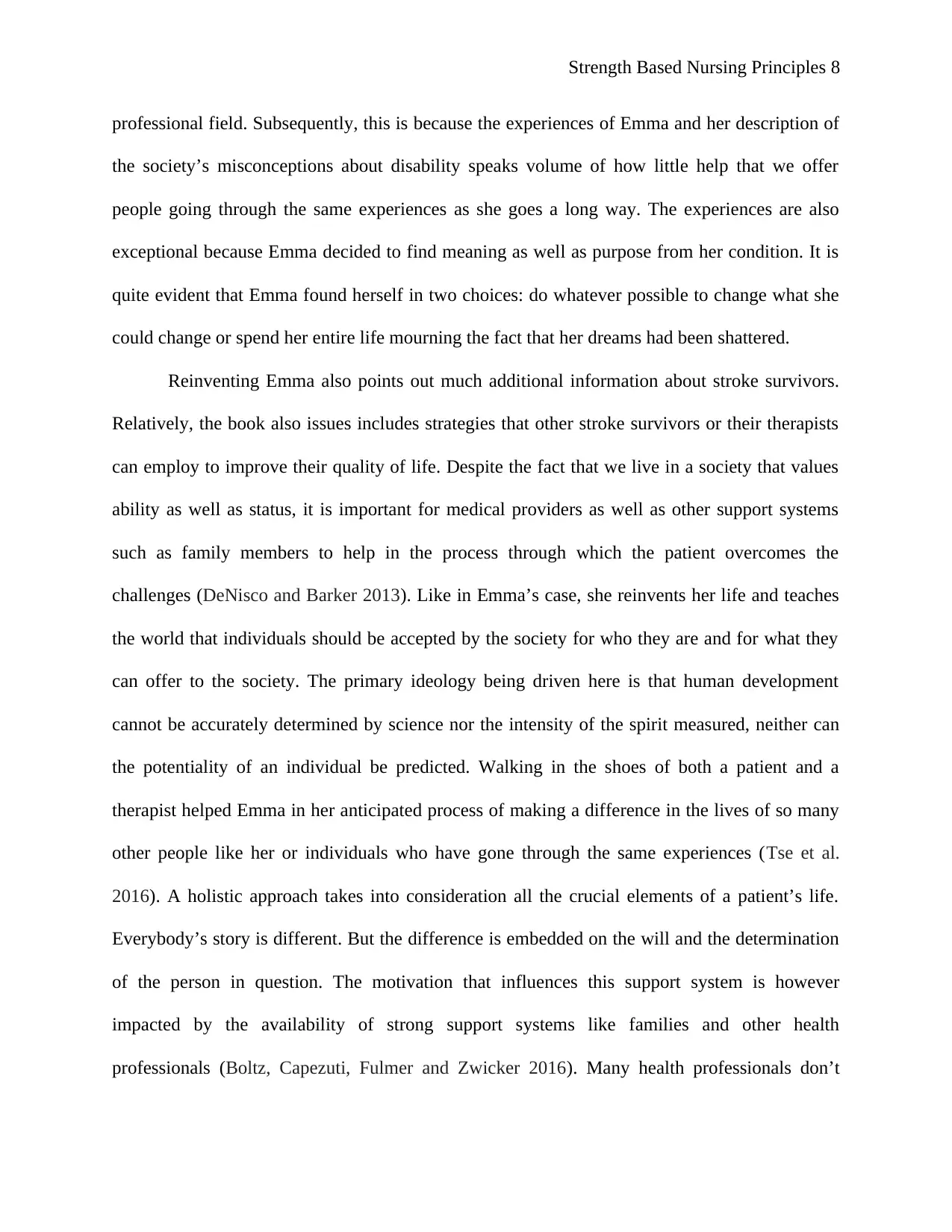
Strength Based Nursing Principles 8
professional field. Subsequently, this is because the experiences of Emma and her description of
the society’s misconceptions about disability speaks volume of how little help that we offer
people going through the same experiences as she goes a long way. The experiences are also
exceptional because Emma decided to find meaning as well as purpose from her condition. It is
quite evident that Emma found herself in two choices: do whatever possible to change what she
could change or spend her entire life mourning the fact that her dreams had been shattered.
Reinventing Emma also points out much additional information about stroke survivors.
Relatively, the book also issues includes strategies that other stroke survivors or their therapists
can employ to improve their quality of life. Despite the fact that we live in a society that values
ability as well as status, it is important for medical providers as well as other support systems
such as family members to help in the process through which the patient overcomes the
challenges (DeNisco and Barker 2013). Like in Emma’s case, she reinvents her life and teaches
the world that individuals should be accepted by the society for who they are and for what they
can offer to the society. The primary ideology being driven here is that human development
cannot be accurately determined by science nor the intensity of the spirit measured, neither can
the potentiality of an individual be predicted. Walking in the shoes of both a patient and a
therapist helped Emma in her anticipated process of making a difference in the lives of so many
other people like her or individuals who have gone through the same experiences (Tse et al.
2016). A holistic approach takes into consideration all the crucial elements of a patient’s life.
Everybody’s story is different. But the difference is embedded on the will and the determination
of the person in question. The motivation that influences this support system is however
impacted by the availability of strong support systems like families and other health
professionals (Boltz, Capezuti, Fulmer and Zwicker 2016). Many health professionals don’t
professional field. Subsequently, this is because the experiences of Emma and her description of
the society’s misconceptions about disability speaks volume of how little help that we offer
people going through the same experiences as she goes a long way. The experiences are also
exceptional because Emma decided to find meaning as well as purpose from her condition. It is
quite evident that Emma found herself in two choices: do whatever possible to change what she
could change or spend her entire life mourning the fact that her dreams had been shattered.
Reinventing Emma also points out much additional information about stroke survivors.
Relatively, the book also issues includes strategies that other stroke survivors or their therapists
can employ to improve their quality of life. Despite the fact that we live in a society that values
ability as well as status, it is important for medical providers as well as other support systems
such as family members to help in the process through which the patient overcomes the
challenges (DeNisco and Barker 2013). Like in Emma’s case, she reinvents her life and teaches
the world that individuals should be accepted by the society for who they are and for what they
can offer to the society. The primary ideology being driven here is that human development
cannot be accurately determined by science nor the intensity of the spirit measured, neither can
the potentiality of an individual be predicted. Walking in the shoes of both a patient and a
therapist helped Emma in her anticipated process of making a difference in the lives of so many
other people like her or individuals who have gone through the same experiences (Tse et al.
2016). A holistic approach takes into consideration all the crucial elements of a patient’s life.
Everybody’s story is different. But the difference is embedded on the will and the determination
of the person in question. The motivation that influences this support system is however
impacted by the availability of strong support systems like families and other health
professionals (Boltz, Capezuti, Fulmer and Zwicker 2016). Many health professionals don’t

Strength Based Nursing Principles 9
understand what it feels like to be a patient and how the little things they do plays a central role
in the recovery path of someone else.
In summary, SBN can help achieve patient and family empowerment, health promotion
and partnership in Australia through some ways. Strengths-based nursing and healthcare is an
approach that guides the process of health delivery for the persons involved as well as their
families. The approach is technically at the first, line regarding the concept of international
healthcare reforms and nursing developments. One of the primary aims of the approach is to
optimize functioning as well as wellbeing, promote healthcare and also create the condition for
healing across one’s lifespan (Gottlieb 2014). Subsequently, the approach works with the aid of
the person and the family resources and strengths in collaboration with the individual, the
healthcare team, and the family. There exist three major principles of strengths-based nursing
and healthcare that touches on its advantages:
Empowerment
Collaborative partnership
Health promotion and healing
Person/family-centered care
The concept of partnership between services are essential to the success of working in
health-promoting ways and this importance is acknowledged by practitioners across all levels of
institutions (Beckett et al., 2013). Also, it is important to point out that successful partnership
strengthens the capability of services as well as projects to broaden the reach by all stakeholders.
Some of the primary benefits of partnerships include:
More efficient resourcing
understand what it feels like to be a patient and how the little things they do plays a central role
in the recovery path of someone else.
In summary, SBN can help achieve patient and family empowerment, health promotion
and partnership in Australia through some ways. Strengths-based nursing and healthcare is an
approach that guides the process of health delivery for the persons involved as well as their
families. The approach is technically at the first, line regarding the concept of international
healthcare reforms and nursing developments. One of the primary aims of the approach is to
optimize functioning as well as wellbeing, promote healthcare and also create the condition for
healing across one’s lifespan (Gottlieb 2014). Subsequently, the approach works with the aid of
the person and the family resources and strengths in collaboration with the individual, the
healthcare team, and the family. There exist three major principles of strengths-based nursing
and healthcare that touches on its advantages:
Empowerment
Collaborative partnership
Health promotion and healing
Person/family-centered care
The concept of partnership between services are essential to the success of working in
health-promoting ways and this importance is acknowledged by practitioners across all levels of
institutions (Beckett et al., 2013). Also, it is important to point out that successful partnership
strengthens the capability of services as well as projects to broaden the reach by all stakeholders.
Some of the primary benefits of partnerships include:
More efficient resourcing
⊘ This is a preview!⊘
Do you want full access?
Subscribe today to unlock all pages.

Trusted by 1+ million students worldwide
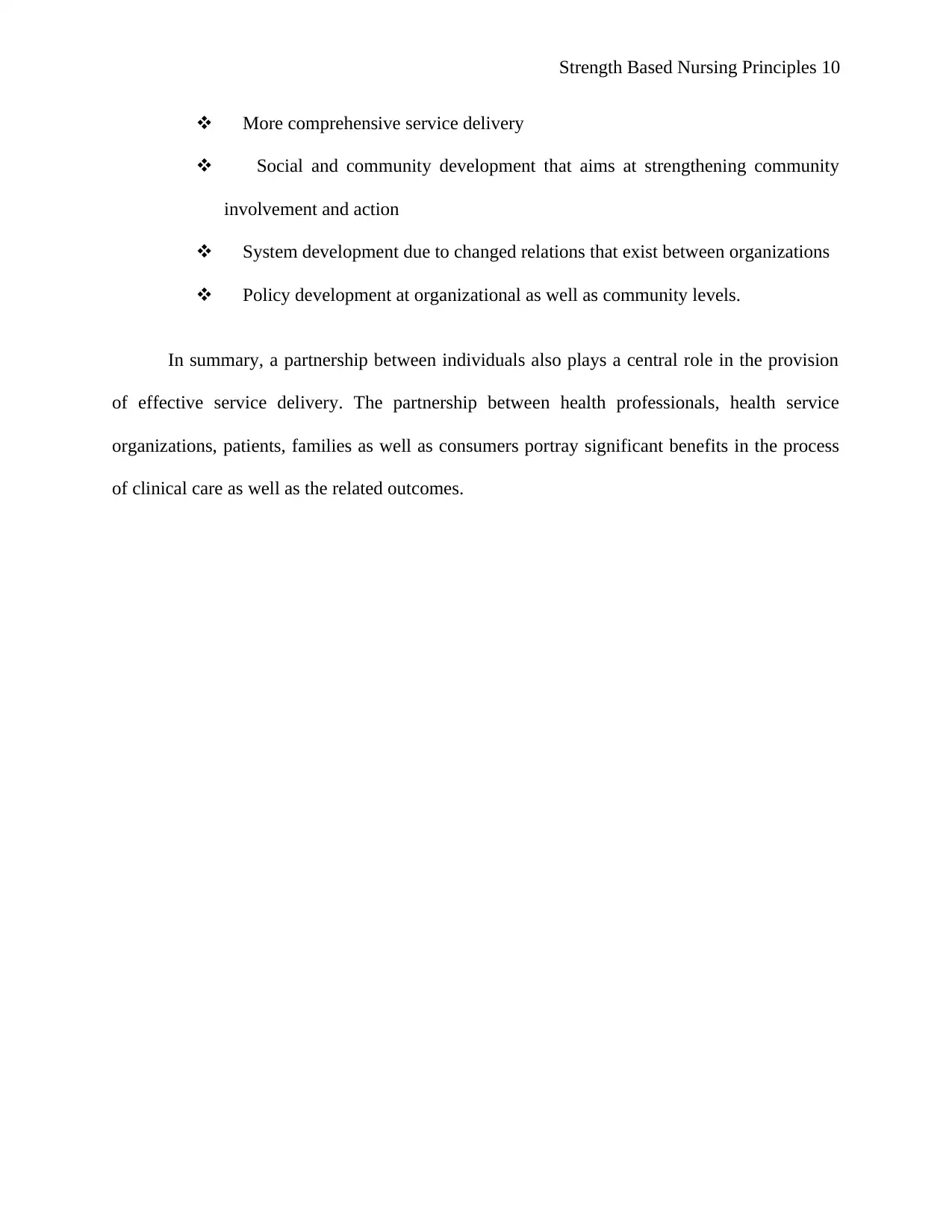
Strength Based Nursing Principles 10
More comprehensive service delivery
Social and community development that aims at strengthening community
involvement and action
System development due to changed relations that exist between organizations
Policy development at organizational as well as community levels.
In summary, a partnership between individuals also plays a central role in the provision
of effective service delivery. The partnership between health professionals, health service
organizations, patients, families as well as consumers portray significant benefits in the process
of clinical care as well as the related outcomes.
More comprehensive service delivery
Social and community development that aims at strengthening community
involvement and action
System development due to changed relations that exist between organizations
Policy development at organizational as well as community levels.
In summary, a partnership between individuals also plays a central role in the provision
of effective service delivery. The partnership between health professionals, health service
organizations, patients, families as well as consumers portray significant benefits in the process
of clinical care as well as the related outcomes.
Paraphrase This Document
Need a fresh take? Get an instant paraphrase of this document with our AI Paraphraser
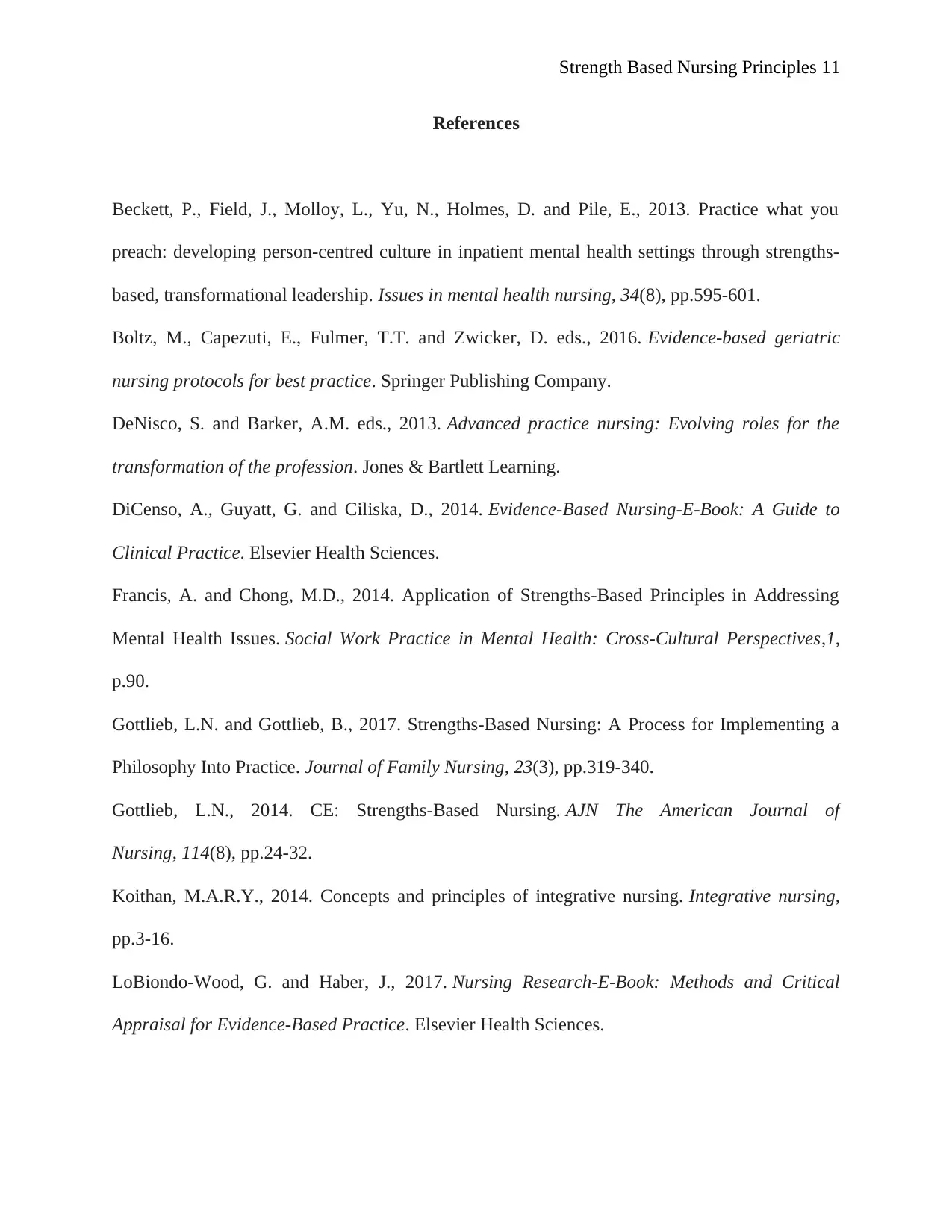
Strength Based Nursing Principles 11
References
Beckett, P., Field, J., Molloy, L., Yu, N., Holmes, D. and Pile, E., 2013. Practice what you
preach: developing person-centred culture in inpatient mental health settings through strengths-
based, transformational leadership. Issues in mental health nursing, 34(8), pp.595-601.
Boltz, M., Capezuti, E., Fulmer, T.T. and Zwicker, D. eds., 2016. Evidence-based geriatric
nursing protocols for best practice. Springer Publishing Company.
DeNisco, S. and Barker, A.M. eds., 2013. Advanced practice nursing: Evolving roles for the
transformation of the profession. Jones & Bartlett Learning.
DiCenso, A., Guyatt, G. and Ciliska, D., 2014. Evidence-Based Nursing-E-Book: A Guide to
Clinical Practice. Elsevier Health Sciences.
Francis, A. and Chong, M.D., 2014. Application of Strengths-Based Principles in Addressing
Mental Health Issues. Social Work Practice in Mental Health: Cross-Cultural Perspectives,1,
p.90.
Gottlieb, L.N. and Gottlieb, B., 2017. Strengths-Based Nursing: A Process for Implementing a
Philosophy Into Practice. Journal of Family Nursing, 23(3), pp.319-340.
Gottlieb, L.N., 2014. CE: Strengths-Based Nursing. AJN The American Journal of
Nursing, 114(8), pp.24-32.
Koithan, M.A.R.Y., 2014. Concepts and principles of integrative nursing. Integrative nursing,
pp.3-16.
LoBiondo-Wood, G. and Haber, J., 2017. Nursing Research-E-Book: Methods and Critical
Appraisal for Evidence-Based Practice. Elsevier Health Sciences.
References
Beckett, P., Field, J., Molloy, L., Yu, N., Holmes, D. and Pile, E., 2013. Practice what you
preach: developing person-centred culture in inpatient mental health settings through strengths-
based, transformational leadership. Issues in mental health nursing, 34(8), pp.595-601.
Boltz, M., Capezuti, E., Fulmer, T.T. and Zwicker, D. eds., 2016. Evidence-based geriatric
nursing protocols for best practice. Springer Publishing Company.
DeNisco, S. and Barker, A.M. eds., 2013. Advanced practice nursing: Evolving roles for the
transformation of the profession. Jones & Bartlett Learning.
DiCenso, A., Guyatt, G. and Ciliska, D., 2014. Evidence-Based Nursing-E-Book: A Guide to
Clinical Practice. Elsevier Health Sciences.
Francis, A. and Chong, M.D., 2014. Application of Strengths-Based Principles in Addressing
Mental Health Issues. Social Work Practice in Mental Health: Cross-Cultural Perspectives,1,
p.90.
Gottlieb, L.N. and Gottlieb, B., 2017. Strengths-Based Nursing: A Process for Implementing a
Philosophy Into Practice. Journal of Family Nursing, 23(3), pp.319-340.
Gottlieb, L.N., 2014. CE: Strengths-Based Nursing. AJN The American Journal of
Nursing, 114(8), pp.24-32.
Koithan, M.A.R.Y., 2014. Concepts and principles of integrative nursing. Integrative nursing,
pp.3-16.
LoBiondo-Wood, G. and Haber, J., 2017. Nursing Research-E-Book: Methods and Critical
Appraisal for Evidence-Based Practice. Elsevier Health Sciences.
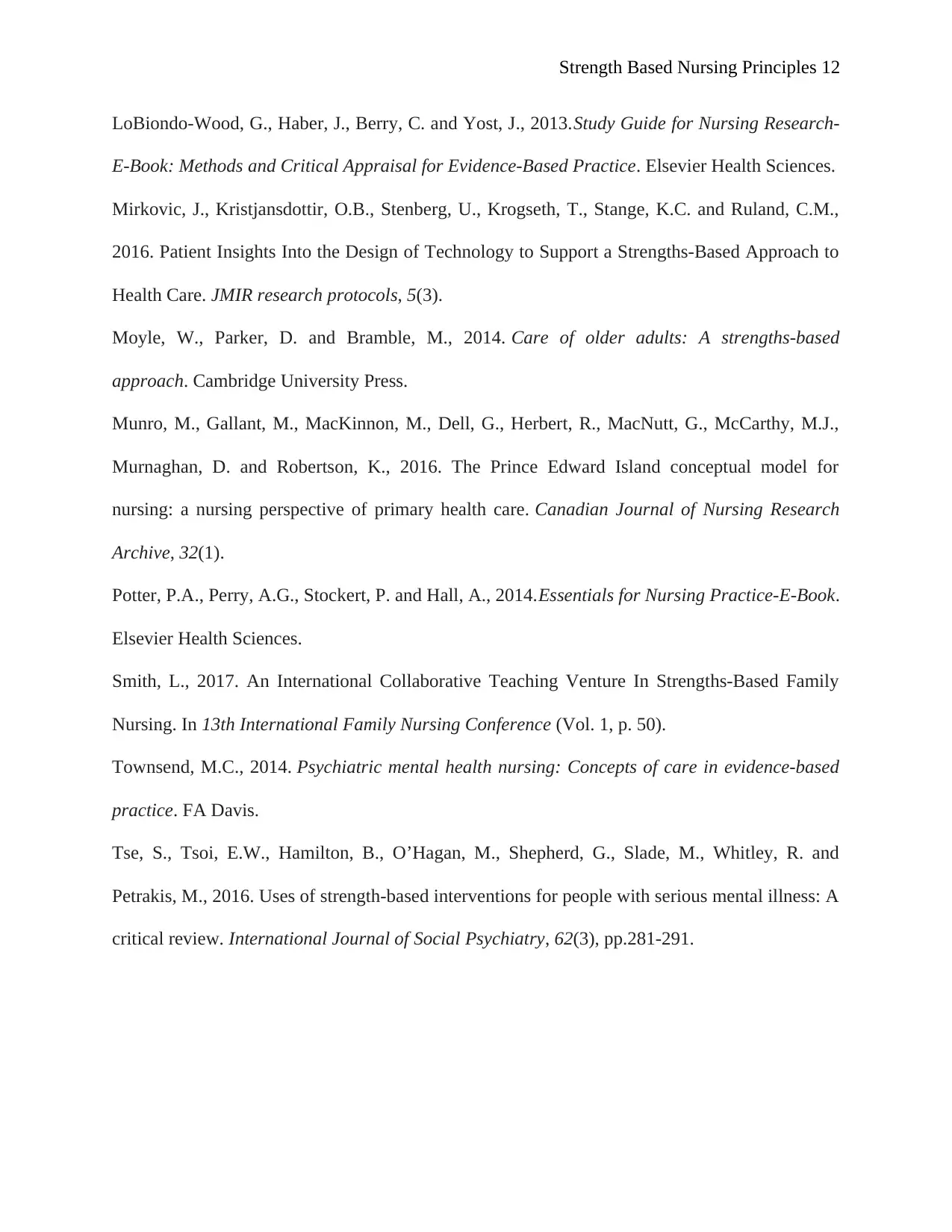
Strength Based Nursing Principles 12
LoBiondo-Wood, G., Haber, J., Berry, C. and Yost, J., 2013.Study Guide for Nursing Research-
E-Book: Methods and Critical Appraisal for Evidence-Based Practice. Elsevier Health Sciences.
Mirkovic, J., Kristjansdottir, O.B., Stenberg, U., Krogseth, T., Stange, K.C. and Ruland, C.M.,
2016. Patient Insights Into the Design of Technology to Support a Strengths-Based Approach to
Health Care. JMIR research protocols, 5(3).
Moyle, W., Parker, D. and Bramble, M., 2014. Care of older adults: A strengths-based
approach. Cambridge University Press.
Munro, M., Gallant, M., MacKinnon, M., Dell, G., Herbert, R., MacNutt, G., McCarthy, M.J.,
Murnaghan, D. and Robertson, K., 2016. The Prince Edward Island conceptual model for
nursing: a nursing perspective of primary health care. Canadian Journal of Nursing Research
Archive, 32(1).
Potter, P.A., Perry, A.G., Stockert, P. and Hall, A., 2014.Essentials for Nursing Practice-E-Book.
Elsevier Health Sciences.
Smith, L., 2017. An International Collaborative Teaching Venture In Strengths-Based Family
Nursing. In 13th International Family Nursing Conference (Vol. 1, p. 50).
Townsend, M.C., 2014. Psychiatric mental health nursing: Concepts of care in evidence-based
practice. FA Davis.
Tse, S., Tsoi, E.W., Hamilton, B., O’Hagan, M., Shepherd, G., Slade, M., Whitley, R. and
Petrakis, M., 2016. Uses of strength-based interventions for people with serious mental illness: A
critical review. International Journal of Social Psychiatry, 62(3), pp.281-291.
LoBiondo-Wood, G., Haber, J., Berry, C. and Yost, J., 2013.Study Guide for Nursing Research-
E-Book: Methods and Critical Appraisal for Evidence-Based Practice. Elsevier Health Sciences.
Mirkovic, J., Kristjansdottir, O.B., Stenberg, U., Krogseth, T., Stange, K.C. and Ruland, C.M.,
2016. Patient Insights Into the Design of Technology to Support a Strengths-Based Approach to
Health Care. JMIR research protocols, 5(3).
Moyle, W., Parker, D. and Bramble, M., 2014. Care of older adults: A strengths-based
approach. Cambridge University Press.
Munro, M., Gallant, M., MacKinnon, M., Dell, G., Herbert, R., MacNutt, G., McCarthy, M.J.,
Murnaghan, D. and Robertson, K., 2016. The Prince Edward Island conceptual model for
nursing: a nursing perspective of primary health care. Canadian Journal of Nursing Research
Archive, 32(1).
Potter, P.A., Perry, A.G., Stockert, P. and Hall, A., 2014.Essentials for Nursing Practice-E-Book.
Elsevier Health Sciences.
Smith, L., 2017. An International Collaborative Teaching Venture In Strengths-Based Family
Nursing. In 13th International Family Nursing Conference (Vol. 1, p. 50).
Townsend, M.C., 2014. Psychiatric mental health nursing: Concepts of care in evidence-based
practice. FA Davis.
Tse, S., Tsoi, E.W., Hamilton, B., O’Hagan, M., Shepherd, G., Slade, M., Whitley, R. and
Petrakis, M., 2016. Uses of strength-based interventions for people with serious mental illness: A
critical review. International Journal of Social Psychiatry, 62(3), pp.281-291.
⊘ This is a preview!⊘
Do you want full access?
Subscribe today to unlock all pages.

Trusted by 1+ million students worldwide
1 out of 12
Related Documents
Your All-in-One AI-Powered Toolkit for Academic Success.
+13062052269
info@desklib.com
Available 24*7 on WhatsApp / Email
![[object Object]](/_next/static/media/star-bottom.7253800d.svg)
Unlock your academic potential
Copyright © 2020–2025 A2Z Services. All Rights Reserved. Developed and managed by ZUCOL.





